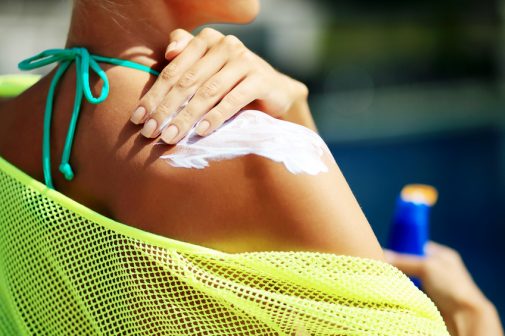Blog: There is no such thing as a safe tan

I love spending time outdoors. But as a dermatologist, I am also very much aware of the “dark side” of the sun. Public awareness of the dangers of sun exposure has risen significantly in recent years, and the US government has officially identified ultraviolet (UV) radiation as a known cause of cancer in humans.
But as I see daily in my dermatology clinic, there is a lot of confusion in regards to the best way to protect our skin from the sun. Given that one in five Americans will develop skin cancer in their lifetime, protecting your skin now can pay off greatly in the future.
We are exposed to two types of UV rays:
- UVA rays, which lead to aging of the skin and can pass through window glass
- UVB rays, which cause sunburn and are blocked by window glass
Both UVA and UVB rays contribute to the risk of skin cancer, as UV light causes invisible damage to skin cells. While some of the injury is repaired, the damage does add up over the years. Tanning is the skin’s response to DNA damage. Therefore, there is no such thing as a safe tan.
Sunscreen is one important way to protect the skin from UV rays. One of the most common questions I get asked is “What is the best sunscreen?” With so many sunscreens currently on the market, picking a good sunscreen can be a daunting task.
Fortunately, the FDA issued new sunscreen labeling regulations in 2011, making it easier to choose a quality sunscreen. I tell my patients to look for the following on the label:
- Broad spectrum
- SPF 30 or higher
- Water resistant or very water resistant
Broad spectrum means a sunscreen protects against both UVA and UVB rays.
SPF (sun protection factor) rating indicates how much UVB light the sunscreen can filter out. It is a reliable measurement of protection against UBV, but does not mean anything in regards to UVA protection. SPF 30 blocks 97 percent of the sun’s rays. Higher number SPFs block slightly more, but no sunscreen can block 100 percent of the sun’s rays.
In addition to choosing an effective sunscreen, proper application is of tantamount importance.
- Use more than you think you need. Most people only apply 25-50 percent of the recommended amount of sunscreen. Coat the skin generously. And remember that it takes one ounce (2 tablespoons or about a shot glass full) of sunscreen to cover the exposed areas of the average adult body.
- Apply sunscreen 20-30 minutes before sun exposure, as it takes some time for the sunscreen to be absorbed into the skin.
- Reapply sunscreen every two hours and immediately after swimming or heavy sweating. Sunscreen gets broken down over time by the sun, and even water resistant sunscreens get rubbed or washed off with sweating, water exposure and toweling. As I tell my patients, there is no such thing as waterproof, rub-proof or sweat-proof sunscreen!
Sunscreens come in lotions, creams, gels, sticks and sprays. Gels are good for hairy areas, while sticks work well for the sensitive skin around the eyes. Most dermatologists do not recommend using spray sunscreens, as there is a risk of inhalation of the sunscreen and it is difficult to know if you have used enough to protect the skin adequately.
If you have sensitive skin, look for sunscreens containing only zinc oxide and titanium dioxide. These are called physical blockers, inert particles that do not penetrate the skin and are less irritating.
They are also the type of sunscreen that should be used on babies six months and older (babies younger than six months should be kept out of the sun). Marketing can be deceiving, so the words “baby” or “sensitive” may or may not mean the sunscreen contains only zinc oxide and/or titanium dioxide. The only way to tell is to look at the active ingredients listed on the bottle.
There has been some concern over the safety of sunscreen ingredients. Sunscreens are regulated as over-the-counter drugs by the FDA, meaning there are safety and effectiveness regulations in place.
The use of sunscreen is supported by scientific studies, and no published studies show that sunscreen is hazardous to human health. For more information on the safety of sunscreen, click here.
There has also been some concern regarding sun exposure and its importance for vitamin D production. The American Academy of Dermatology does not recommend getting vitamin D from sun exposure. A healthier alternative is getting vitamin D from a healthy diet and/or vitamin supplements.
Finally, while picking the right sunscreen and applying it properly will help minimize the sun’s effects on the skin, it will not fully protect you. Additional measures, such as wearing sunglasses, a broad-brimmed hat and sun-protective clothing, as well as avoiding sun exposure from 10 am to 4 pm, will help maximize sun protection. And don’t forget to protect yourself on overcast days, as 70-80 percent of the sun’s rays travel through clouds.
So head outdoors and enjoy the summer days! Armed with these tips on sun precaution, you can enjoy the sunshine safely.
Related Posts
Comments
About the Author
Dr. Liborka Kos is a pediatric dermatologist with Advocate Children’s Medical Group. She is affiliated with Advocate Children’s Hospital – Park Ridge, Advocate Condell Medical Center and Advocate Lutheran General Hospital.

















